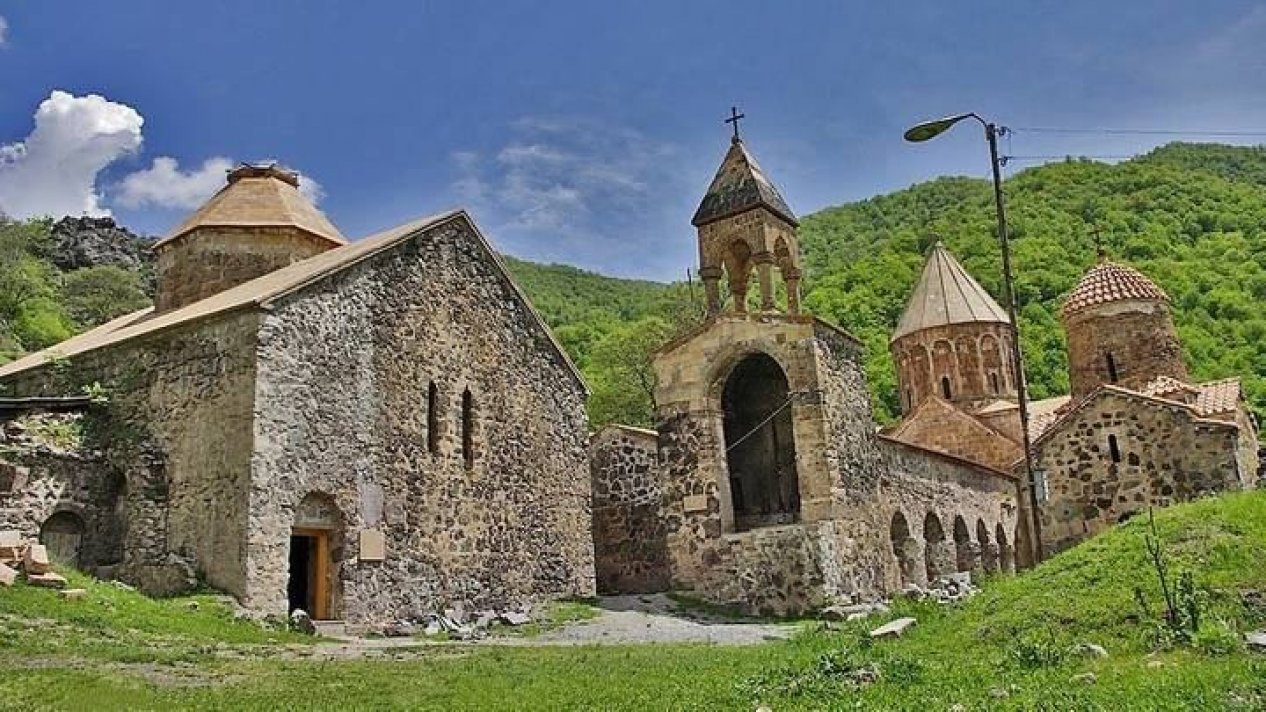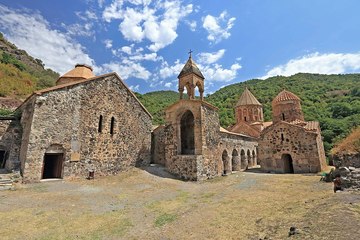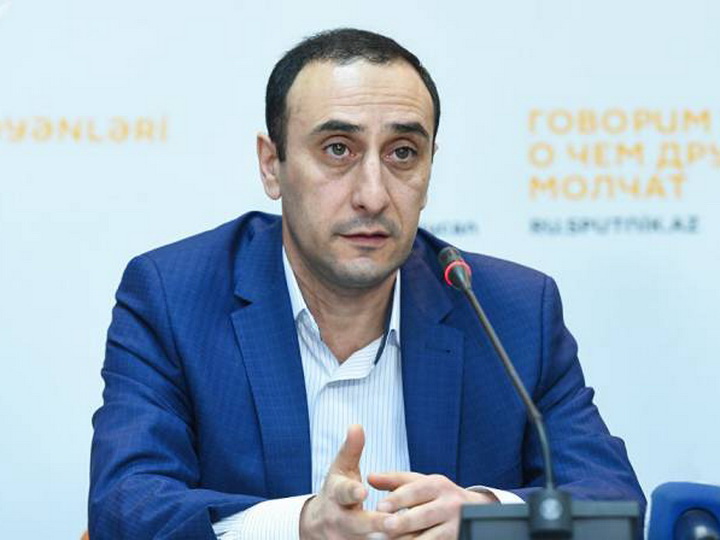
Azerbaijan has been prohibiting Armenian clergymen from entering Dadivank Monastery for the past three months already. The Azerbaijanis aren’t even letting them enter the premises of the monastic complex.
During a conversation with Armenian News-NEWS.am, Father Nerses Harutyunyan of Dadivank Monastery said Azerbaijan’s reasons aren’t substantiated.
“They always find some reasons that do not correspond to reality, be it a pandemic or a destroyed road. Now they just say no and that's it. Dadivank also lost its pilgrims. Azerbaijan has banned them from entering the territory of the temple since May this year, and again without any justification.”

Indeed, the ancient Albanian temple of Khudaveng was closed to Armenians at the end of April. The Head of the Information System of Mother See of Holy Etchmiadzin Priest Vahram Melikyan confirmed the information that the Azerbaijani military on April 25 banned pilgrims from entering Khudaveng.
"On April 25, representatives of the Armed Forces of Azerbaijan, under the pretext of an epidemic, prohibited the Primate of the Artsakh Diocese of the Armenian Apostolic Church, Archbishop Pargev Martirosyan, Bishop Vrtanes Abrahamyan and a group of pilgrims to enter the territory of Dadivank. I would like to note that on this day the ordination to the priesthood of a monk living in the monastery was planned, and it was agreed with the command of the Russian peacekeepers," complained Melikyan, apparently forgetting about the need to coordinate such issues, primarily with the Azerbaijani side. The representative of Echmiadzin considers this "another expression of Armenophobia, encroachment on Armenian shrines and on the spiritual life of the Armenian people."
The Khudaveng monastery, according to historians, is not an Armenian shrine, but belongs to the Albanian church.
“Christian shrines located on the deoccupied lands will be returned to their true owners, including the Albanian-Udi community. The Albanian-Udi community of Azerbaijan has the right to the Dadivank (Khudavank) complex in Kalbajar, as well as to other Armenianized Albanian churches located in the liberated territories of Azerbaijan. Following simple logic, it is safe to say that if the monastery belonged to the Armenian side, it would have developed it back in the tsarist and Soviet times. But we know that the process of privatization of Albanian churches began in Karabakh only after the occupation of Azerbaijani territories by Armenia,” historian Rizvan Huseynov believes.

“Khudavank has a very ancient history. One of the disciples of the Apostle Thadeus is buried here. Moreover, if the Armenian side claims that this is an Armenian temple, then the question arises: why, then, there have never been Armenians on this territory? This is the main reasoning that these monuments have nothing to do with Armenians. I will even say more - if there is an Armenian church somewhere, this does not mean that all neighboring territories must necessarily belong to the Armenians. Armenians have their churches in the US, in Russia, and anywhere in the world. If we follow this logic, they can claim the territory of any country,” the historian notes.
Chairman of the Albanian-Udi Christian community of Azerbaijan, Robert Mobili, also emphasizes that present-day Azerbaijan is the heir to the historical Caucasian Albania. Monuments dating back to the IV, V, VI, IX, XII centuries have survived. Karabakh holds a special place here.
As for the return of Albanian temples to their true owners, after the liberation of the Kalbajar region, a preacher was appointed to the Khudaveng monastery - Rafik Danakari, deputy chairman of the Albanian-Udi Christian community.

According to Danakari, there are significant differences between Albanian and Armenian monasteries. The main difference is associated with the elements of the khachkar, which is the cultural heritage of the Caucasian Albanians, the shape of the altar, the structure and architecture of the building, as well as the celebration of the divine liturgy.
"Translated from the ancient Albanian language, Khudaveng means Temple of God. Khudaveng was built in the 9-13th centuries. The construction was completed during the reign of the Albanian prince Vakhtang. All this is evidence of the Albanian origin of the monastery," he said.
"The Khudaveng monastery has nothing to do with the Armenians. The ancient apostles never came to Armenia. At that time, there was no state called Armenia in the Caucasus at all. Khudaveng belongs only to the peoples living in the territory of Caucasian Albania. Today we (Albanian-Udi Christian community Azerbaijan - ed.) are its heirs. ”The Khudaveng Monastery belongs to us, we proved it and managed to “drown out” the voices of Armenians on this issue,” Rafik Danakari summed up.
Azerbaijani President Ilham Aliyev said that the Khudaveng Church, freed from occupation, has already been returned to its true owners, our Udi brothers.
"The liberated church of Khudavang has been returned to its true owners, to our Udi brothers. Even though the Armenians changed its name and appearance as a result of fraud, tried to Armenianize it, they failed to do so. Our Udi brothers have already performed their service in the Khudavang church. All other churches belonging to Caucasian Albania, including the church in Nij settlement," said President Ilham Aliyev.
Thus, it is proved that the monastery, the entrance into which is limited first to Armenian pilgrims, and then to priests, is not Armenian. But this, apparently, is not the only reason for such a step on the part of the Azerbaijani military personnel.
According to Rafik Danakari, when visiting Khudaveng Monastery in December 2020, they unexpectedly met with Armenian clergy. Danakari told about this to the Trend news agency. The Armenian clergy in the church tried to prevent members of the Albano-Udi community from visiting the monastery, but they failed to do so.
“The Armenian clergy tried to prevent us from visiting the monastery, they wanted to ban the filming. We explained to them that the monastery did not belong to the Armenians, but to us - the Udins. We presented them the facts that they destroyed all the historical and religious objects in the monastery after its appropriation in 1993. Our trip to the monastery was timed to coincide with the great Christian holiday, which was celebrated on December 4. Despite all the obstacles, we prayed and lit candles, as well as filmed,” said the preacher of the monastery.
Rafik Danakari added that members of the Albano-Udi community objected to the presence of Armenian clergy in the monastery and told the Russian peacekeepers about this: "We do not agree that there are Armenian clergymen on Azerbaijani territory. The peacekeepers replied that they are here temporarily.”
In early May, representatives of the Udi community again made a trip to Kalbajar in order to perform the Easter service, but the Armenian priests again tried to hinder them from doing so.
In addition, in 1994, after the occupation of the Kalbajar region and the conclusion of a temporary truce, the Khudaveng complex was declared a functioning monastery of the "Artsakh" Diocese of the Armenian Apostolic Church. The monks of the complex were headed by a certain "Father Hovhannes" (Ter-Hovhannes Hovhannisyan), known for atrocities against the peaceful Azerbaijani population during the first Karabakh war in the 90s of the last century. By the way, when the second Karabakh war began, this "religious figure" with a machine gun in his hands began to call for the murder of Azerbaijanis.

As is seen, the Azerbaijani side had enough reasons to close the temple for the Armenians who had been illegally there for almost thirty years.
Thus, we proved that Khudaveng Monastery is not an "Armenian shrine", and the non-admission of Armenian priests and pilgrims there is not a manifestation of "Armenophobia", but a consequence of their illegal actions, as well as illegal stay on the territory of the temple in general.




















